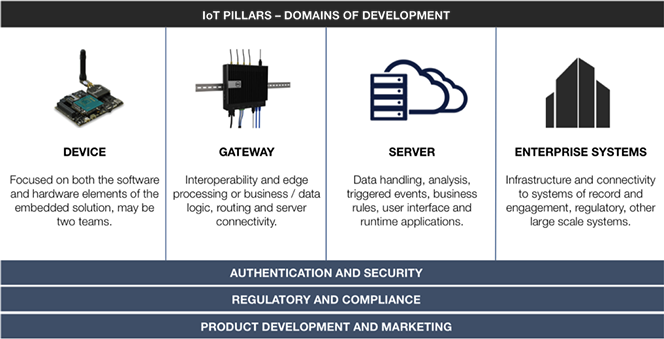IoT and the Developer Engineer
IoT SCORECARD
KNOWLEDGE TO POWER THE BUSINESS OF IOT
NEW: IoT PLATFORM RFx TEMPLATE - CLICK HERE
menu
Every day we are greeted with reams of new content about how incredibly large the IoT opportunity will be for enterprise. Everything connected, always on, a marketer’s dream, a new day for businesses and consumers. What’s not readily discussed is the dynamic changes coming to the organizations that will build all of these “smart” solutions – the developer engineers that will weave together the connectivity and user experience to make all of this market potential a reality.
Most profound in the coming change is not the languages, APIs or concepts developers will need to work with, it’s more about approach and the way development teams will organize around projects.
Circling the Ecosystem
In a previous post on IoTscorecard.com, the concept of four pillars that make up the IoT ecosystem was defined – encompassing the devices, gateways, servers and ultimately enterprise systems of record and engagement. This is a good rule of thumb for the developers in your organization as well. Many organizations have already migrated to a “mobile first” development approach, and that will ease the transition to the next iteration: the concept of each pillar, or domain, effectively architecting a unified solution that comes together at succinct points in the project.
It’s a little bit more than shuffling the players on the board. There are unique elements to each, just as we’ve observed with mobile and other development trends. The domains of development shape up roughly like this:

So what can the enterprise do to ensure development and engineering efficiency is maximized for building the IoT? Here are three places to start:
[1] Bridging the legacy skills gap
What’s clear in any IoT development scenario is the need to bridge old and new. IoT will push the issue of legacy systems interacting with high velocity, real time data and business logic – something they were never intended to support at true IoT scale. At the same time, developers and architects are often cut across the same lines. I don’t know many iOS developers that are experts at AS400 or CICS. There is a real need to not only understand but cross-train and propagate best practices for legacy infrastructure, protocols, and how to connect them to the new digital domain and cloud ecosystem. Platforms help, but real efficiency lies in the nuances of each system.
[2] Don’t let traditional priorities submarine progress
More than ever, IT leaders will need to ensure the IoT missions their organizations are signing up for are achievable. That means an articulated product strategy, use cases, demand intelligence and alignment with how the business will generate ROI or revenue. Don’t accept the projects that can’t demonstrate these qualities. I’ve seen a few large organizations begin to force prioritization of development projects back onto the business by offering capacity, rather than a linear request process. This is really effective beyond IoT, but I suspect the demand for development activity will force most organizations to rethink their prioritization strategy.
[3] Set good expectations for the incubator – innovation lab model
It’s hip to have an innovation lab or incubator in large enterprise, that little startup module tucked away in a cool Valley-like location where cutting-edge technology experimentation is funded and sponsored by the business. What’s rarely clear is how to map those efforts and outputs back into the business. How will the incubator’s technology stack allow us to integrate what they develop? What are the conflicts? Is there a plan? Also, consider the talent equation. It’s a good bet your top development talent will want to be part of the most innovative group in the company, and it makes sense to let them drive. But ensure their mission is clear regarding the core business – at some point solutions will need to migrate back to the core for deployment and realization.
Engaging development for IoT with “business as usual” organization won’t get the job done. The black hole that’s created means wasted time, huge incremental costs and delayed go to market with game-changing solutions. Maintaining the segmentation of traditional IT infrastructure and newer IoT developers will not succeed. We must cross-train and integrate IoT development into our organizations to create a new breed of enterprise IoT engineer.
iotscorecard is presented exclusively by ClearBlade Inc. | clearblade.com | info@clearblade.com